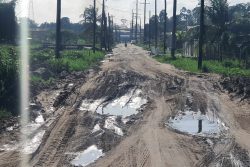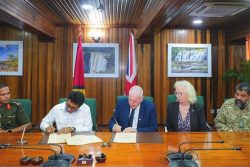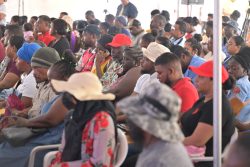The Vreed-en-Hoop Shorebase Inc (VEHSI) on Saturday announced the opening of Phase 1 of a state-of-the-art port facility at Plantation Best, West Bank Demerara.
At the mouth of the Demerara River, this shore base is sited on around 50 acres comprising materials reclaimed from the sea bed with Belgian company Jan De Nul the main architect of the development and also an investor in the project. ExxonMobil will be leasing the facility for 20 years and it will be the locus of the development of the Yellowtail project and others that are in the works.
VEHSI said in a release that Phase 1 is a precursor to what is expected to become the larger Port of Vreed-en-Hoop that seeks to improve Guyana’s long-term maritime offerings. The project was developed by VEHSI, a joint venture between NRG Holdings Inc., a 100% Guyanese-owned consortium, and Jan De Nul, and is one of the largest private-sector investments in Guyana’s history, with an estimated cost of over US$260 million so far. Jan De Nul disclosed on Saturday that it has put US$100m into the project and the remainder has presumably been provided by the Alphonso and Boyer families.
VEHSI added that the opening of the shore base is expected to bring significant economic and employment opportunities to Region 3. During its construction phase, the project has created hundreds of jobs and VEHSI said it is now expected to generate “massive employment” and will continue to grow as it keeps expanding.
In addition, local businesses and the surrounding communities have already seen tangible benefits, VEHSI said. During construction, over US$60 million was invested in the deepening of the Demerara River channel; the channel has been widened from approximately 50 meters to 100 meters; it has also been extended from 18 KM to over 28 KM in length from the mouth of the river to provide access to larger vessels with deeper draught.
Furthermore, the community of Plantation Best has seen the addition of new roads and bridges as well as the improvement of existing infrastructure, in the process, raising the profile of the community and increasing property values.
The area commissioned will serve as a Subsea Umbilicals, Flowlines, and Riser (SURF) shore base for ExxonMobil Guyana Limited (EMGL) and will also provide essential services related to the oil and gas sub-sea infrastructure such as equipment storage, inspections, repairs and fabrication.
VEHSI acknowledged the “steadfast support” of the Government of Guyana, particularly President Ali, for his “rapid response and unwavering commitment to the project’s development”.
The Alphonso and Boyer families must be complimented on this investment in the oil and gas economy. As was the case with Guyana Shore Base Inc ( GYSBI), local companies have stepped forward with capital in what was an entirely new industry for them. Clearly the Alphonso and Boyer families expect that the lease fees and ribbon development associated with the project will yield a satisfactory rate of return on their investment. This is another seminal moment for the local private sector and it will no doubt encourage others to consider like investments associated with oil and gas.
The creation of the island was a monumental undertaking. At one point Jan De Nul advertised for 2,000,000 metric tonnes of sand and eventually employed its giant dredger M.V. Galileo Galilei to undertake the task of gathering material. Questions remain about the impact of all of these works on the artisanal fishing industry, on tidal and river movements in the immediate area and the long-term structural integrity of the facility. These are areas that NRG Holdings Inc should see as valuable research topics utilizing researchers and scientists from the University of Guyana.
There are a few other things to be noted about the launch of VEHSI phase one. Aside from the promised non-oil businesses to be developed at the port this investment represents a further entrenching of assets and natural resources into the petroleum industry. In turn, this investment will see a range of other developments solely catering to the oil and gas industry. Just as how both sides of the Demerara River have already been enlisted in the aid of the oil and gas industry for everything from lay down yards to the disposal of toxic waste so it will be on the West Coast of Demerara and further up. Thus far the facility will create hundreds of jobs and perhaps myriad training opportunities as is the case with GYSBI. However, in the main, apart from whatever taxes are paid, the benefits of this shore base will accrue almost entirely to the Alphonso and Boyer families, Jan De Nul and ExxonMobil and its partners. It is perhaps why, with a slight grin, the Head of EMGL, Mr Routledge said at the event that the artificial island shore base constituted “The first new land in Guyana…forever” without the slightest qualm about the unjust Production Sharing Agreement imposed upon this country and its people. The more local wealth is concentrated in the oil and gas industry the greater the risk of the Dutch Disease taking substantial hold.
Aside from the investment of Robert Badal and others in the hospitality sector including the Alphonso group there has not been large scale investment to diversify away from oil and gas. Indeed, several of the investments in the hospitality sector are geared towards facilitating oil and gas employees. There have been smaller investments in agro-processing and tourism but not on the scale that would suggest that the economy is being significantly reoriented away from oil and gas. The evidence is to the contrary when one considers the state’s gas to energy project and its steeply rising cost. Guyana is being further embedded in the oil and gas economy with all of the repercussions entailed.
In an election year, the government will be challenged to show cogent evidence that it has begun engineering the country’s path away from oil and gas. The evidence is slight at the moment. The investment in the cultivation of soy bean, corn and other crops sounds very promising. However, the size and consistency of the crops are still to be determined along with a calculation of the inputs of the private sector and the government and how these two streams benefit the economy and the people. The construction expansion is linked to oil and gas, roads, the government’s public sector programme and the housing market which the state is driving and its sustainability is left to be seen. At the commissioning of the shore base, President Ali again repeated that the creation of 50,000 jobs as promised in the party’s manifesto was “done and dusted”. That’s according to the Office of the President but evidence to substantiate this figure is yet to be delivered.
Undoubtedly the launch of Phase 1 of the shore base project is an important development and investment by local businessmen in partnership with Jan De Nul. It, however, underlines again the deepening integration of the economy with oil and gas without commensurate fuelling of the non-oil economy.








